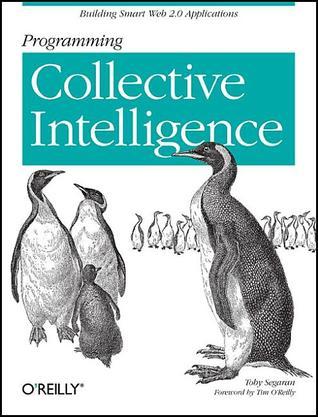the best books for developers

Topics: Artificial Intelligence, Machine Learning, Algorithms, Data Mining, Natural Language Processing, Recommender Systems, Search Engines, Social Network Analysis
By Toby Segaran
9780596529321
"Programming Collective Intelligence" by Toby Segaran is like your secret recipe for creating smart, data-driven web applications. It's all about making your software smarter by tapping into the wisdom of crowds.
First, it introduces the concept of collective intelligence – how groups of people or data can be way smarter than just one person. You'll see how websites like Amazon and Netflix use this to recommend stuff you'll love.
The book dives into the world of data and algorithms. You'll learn how to gather data from various sources like websites, social media, and user-generated content.
Machine learning is like the star of the show. You'll discover how to use algorithms to classify data, make predictions, and find hidden patterns. It's like teaching your software to learn and get better over time.
The book also explores clustering and searching – how to group similar items and find what you're looking for in a sea of data. It's like creating a map in a vast treasure hunt.
Don't forget about optimization – making your software work faster and smarter. You'll see how to use techniques like genetic algorithms and simulated annealing to find the best solutions.
Social networks and recommendations are a big deal. The book shows you how to build your own recommendation engine and use network analysis to uncover valuable insights.
And it wraps up with a peek into the future – how collective intelligence is shaping the world of AI and what's coming next.
In a nutshell, "Programming Collective Intelligence" is like your secret weapon for creating web applications that are more than just code – they're smart, data-savvy, and able to harness the collective wisdom of the internet. Whether you're a developer or just curious about the magic behind recommendation engines and data-driven apps, this book is your backstage pass to the world of collective intelligence.
Chapter 1: Introduction to Collective Intelligence
In the opening chapter, Segaran introduces the concept of collective intelligence and its application in building smart web applications. He provides an overview of how websites like Amazon and Netflix use collective intelligence to make recommendations and previews the topics covered in the book.
Chapter 2: Making Recommendations
Chapter 2 delves into the heart of recommendation systems. Segaran explains how to create recommendation engines that analyze user data and suggest relevant items. He introduces collaborative filtering and content-based filtering techniques, laying the foundation for building personalized recommendation systems.
Chapter 3: Discovering Groups
This chapter explores the concept of clustering and grouping similar items or users. Segaran discusses hierarchical clustering, k-means clustering, and other techniques for discovering patterns and relationships within data. Readers learn how to apply clustering to categorize data effectively.
Chapter 4: Searching and Ranking
In Chapter 4, the focus shifts to search and ranking algorithms. Segaran explores how to implement search engines that rank results based on relevance. He introduces techniques like TF-IDF (Term Frequency-Inverse Document Frequency) and PageRank, providing insights into improving search quality.
Chapter 5: Optimization
Chapter 5 is all about optimization techniques for making web applications smarter and faster. Segaran discusses genetic algorithms, simulated annealing, and other optimization methods. Readers gain an understanding of how to fine-tune algorithms and parameters for optimal performance.
Chapter 6: Document Filtering
This chapter explores document filtering and classification. Segaran discusses techniques for categorizing and tagging content, making it more discoverable and relevant. Readers learn how to implement document filtering systems for tasks like spam detection and content organization.
Chapter 7: Decision Trees
Chapter 7 introduces decision trees as a machine learning tool. Segaran explains how decision trees work and how to use them for classification tasks. He provides practical examples of decision tree applications, such as predicting user behavior.
Chapter 8: Neural Networks
In this chapter, Segaran dives into neural networks, a powerful machine learning technique. He demystifies neural network concepts and shows how to build and train neural networks for tasks like pattern recognition. Readers gain insights into the capabilities and limitations of neural networks.
Chapter 9: Bayesian Filtering
Chapter 9 explores Bayesian filtering, a probabilistic approach to decision-making. Segaran discusses Bayesian networks and how they can be used for tasks like spam filtering and recommendation systems. He provides practical guidance on implementing Bayesian filtering algorithms.
Chapter 10: Support Vector Machines
The focus of this chapter is on support vector machines (SVMs), a machine learning method for classification and regression tasks. Segaran explains SVM principles and demonstrates their use in solving real-world problems. Readers learn how to apply SVMs to data analysis and prediction.
Chapter 11: Finding Independent Features
Chapter 11 discusses techniques for finding independent features in data. Segaran explores principal component analysis (PCA) and singular value decomposition (SVD) as methods for reducing dimensionality and uncovering hidden patterns. Readers gain insights into feature extraction and data reduction.
Chapter 12: Evolutionary Intelligence
In the final chapter, Segaran looks at evolutionary intelligence and genetic algorithms as tools for optimization and problem-solving. He discusses evolutionary strategies and genetic programming, showing how they can be applied to various tasks, including game playing and function optimization.